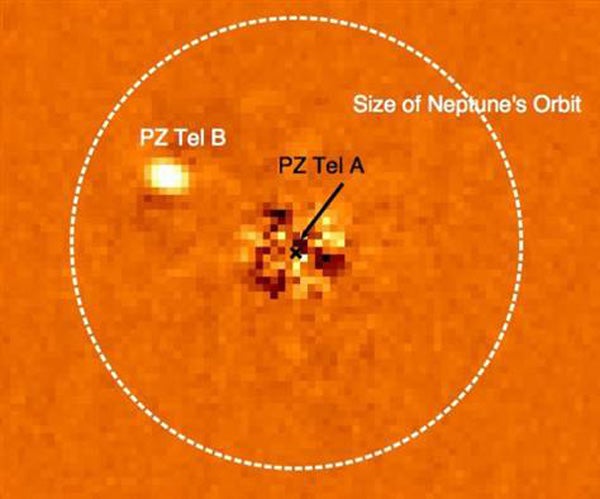Astronomers have directly imaged a young brown dwarf — or failed star — in a tight orbit around a young nearby Sun-like star. Beth Biller and Michael Liu from the University of Hawaii, along with Laird Close, Eric Nielsen, Jared Males, and Andy Skemer from the University of Arizona, made the rare find using the Near-Infrared Coronagraphic Imager (NICI) on the international 8-meter Gemini-South Telescope in Chile.
What makes this discovery special is the proximity between the 36 Jupiter-mass brown dwarf companion, PZ Tel B, and its primary star named PZ Tel A. Both are separated by only 18 astronomical units (AU), similar to the distance between Uranus and our Sun. Most young brown dwarf and planetary companions found by direct imaging are at orbital separations greater than 50 AU — larger than the orbit of Pluto (40 AU). In addition to its small current separation, in just the past year, the researchers observed PZ Tel B moving quickly outward from its parent star.
An older image, taken 7 years ago and reanalyzed by Close, showed PZ Tel B was completely obscured by the glare from its parent star as recently as 2003, indicating its orbit is more elliptical than circular.
“Because PZ Tel A is a rare star being both close and young, it had been imaged several times in the past,” said Close. “So we were quite surprised to see a new companion around what was thought to be a single star.”
“PZ Tel B travels on a particularly eccentric orbit,” said Biller. “In the last 10 years, we have literally watched it careen through its inner solar system. This can best be explained by a highly eccentric, or oval-shaped, orbit.”
The host star, PZ Tel A, is a younger version of the Sun, having a similar mass but a young age of only 12 million years (about 400 times younger than our Sun). In fact, the PZ Tel system is young enough to still possess significant amounts of cold circumstellar dust, which may have been sculpted by the gravitational interaction with the young brown dwarf companion.
This makes the PZ Tel system an important laboratory for studying the early stages of solar system formation. With an estimated mass of 36 times that of Jupiter, PZ Tel B’s orbital motion has significant implications for what type of planets can form — and whether planets can form at all — in the PZ Tel system.
Because PZ Tel B is so close to its parent star, special techniques are necessary to distinguish the faint light of the companion from the light of the primary star. PZ Tel B is separated by about 0.33 arcsecond from PZ Tel A, equivalent to a dime seen at a distance of 7 miles (11 kilometers). In order to take pictures so close to the star, the team used an adaptive optics system coupled to a coronagraph in order to block out excess starlight, and then applied specialized analysis
techniques to the images to detect PZ Tel B and measure its orbital motion.
PZ Tel B was discovered using Near-Infrared Coronagraphic Imager (NICI), the most powerful high-contrast instrument designed for imaging brown dwarfs and extrasolar planets around other stars. NICI can detect companions 1 million times fainter than the host star at just 1 arcsecond separations. An international team of researchers drawn from across the Gemini Telescope community is currently carrying out a 300-star survey with NICI, the largest high contrast imaging survey conducted to date.
“We are just beginning to glean the many configurations of solar systems around stars like the Sun,” said Liu. “The unique capabilities of NICI provide us with a powerful tool for studying their constituents using direct imaging.”










